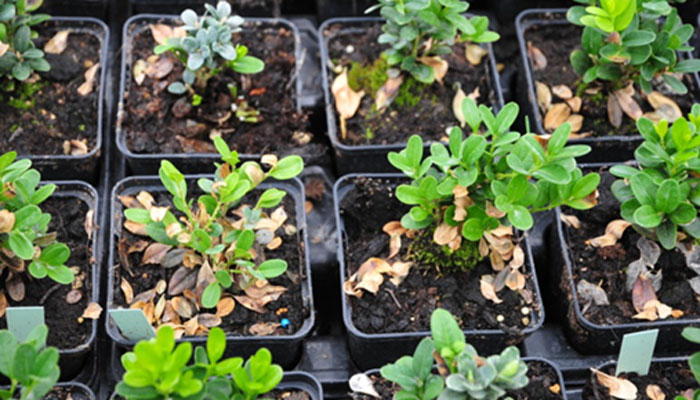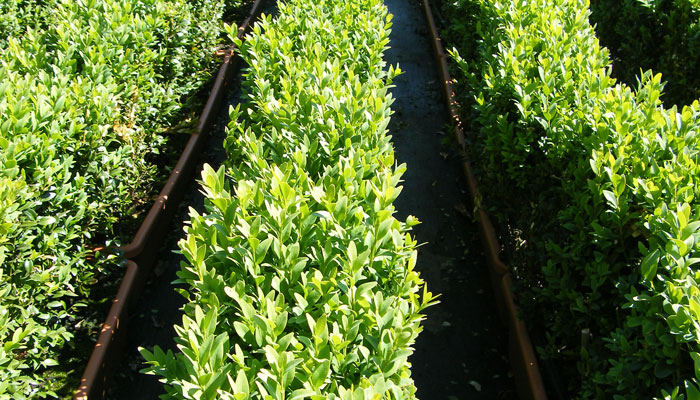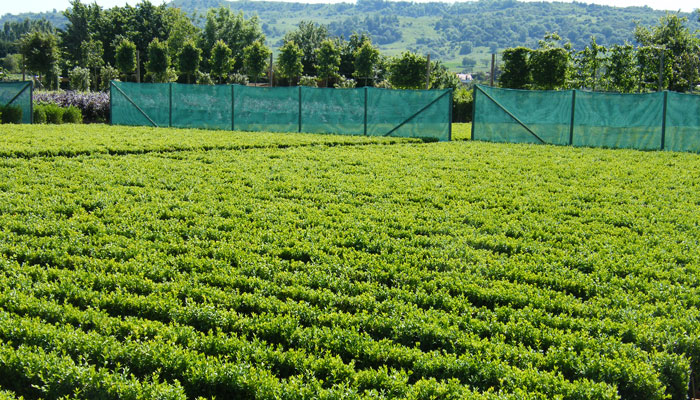When meeting growers in Boskoop and visiting the GG-Plus Trade show in Zundert, I have taken plenty of interest in the propagation and production of Taxus baccata (the common English Yew) and Buxus sempervirens (English Box). Both are useful for garden and hedging purposes.
To grow quality Buxus sempervirens in the field, good drainage is essential and the soil tends to be managed on a seven-year rotation, with a break crop of Sorghum. Many UK growers import four or five year old plants from the Netherlands or Belgium. Harvested using special lifting machinery in the autumn, the plants are cold stored and exported to specialist UK growers to be grown on in larger pots and containers to supply garden centres andthe landscape trade.
Unfortunately, in recent years Buxus sempervirens has become literally ‘PLAGUED’ with problems – in particular Buxus ‘Blight’ infecting Buxus spp with Cylindrocladium buxii during the summer growing season. Some believe climate change is the root cause, with intermittent heavy rainfall followed by hot and sunny intervals.
To help Buxus plants protect themselves, UK and Dutch growers have responded quickly to improve soil management through soil biology and to boost their understanding of plant nutrition - both in the field and in containers and troughs. One area highlighted has been problems caused by calcium deficiency.
Help is at hand
In Buxus spp a good warning sign of calcium deficiency is new growth with thin terminal shoots. For clarification, the NRM Laboratory offers a Foliage Analysis Service. Growers can submit leaf samples for the service to check the crop’s calcium status. (www.nrmltd.co.uk)
As with all plant deficiencies, this can be remedied with the correct nutrition programme. A product I am seeing used by more and more nursery stock growers in the UK and Netherlands is Agroleaf Power Calcium. A precision nutrition product, this water-soluble foliar fertilizer (11-5 -19 +9 CaO+2.5 MgO +TE) contains M-77 chelated trace elements and stimulant package – which in short optimises uptake through the foliage.
Highly concentrated, Agroleaf Power Calcium delivers a fast response helping to strengthen new shoots and cell walls – equipping plants to withstand winter damage and disease invasion.
Impressive results from UK trials have shown Agroleaf Power Calcium applied to Buxus crops from May to mid September can produce 18% higher calcium levels in the terminal shoots compared to untreated crop. Indeed, twenty terminal shoots taken from the treated Buxus weighed four times more than the untreated.




Tips on application
It is best to apply Agroleaf Power Calcium when the Buxus plants are actively growing – the more actively the better. This is a foliar feed so apply to the terminal shoots and not the ground!
It makes sense to apply in summer when the leaf stomas are open – ie the plant is actively breathing and photosynthesising. However as with all sprays, to minimise leaf scorch and evaporation it is best to avoid spraying in periods of bright sunlight and high mid day temperatures.
Specially formulated to dissolve quickly, Agroleaf products are easy to apply – and spray nozzle blockages are unheard of! While an air assisted knapsack sprayer is ideal, for larger areas a boom sprayer is more practical.
Whether applying to open field or container grown crops, the recommended rate is 3-5 kg in 200-600 litres per hectare. For maximum effect when Buxus growth is flushing, applications can be repeated two or three times at weekly intervals. If mixing with pesticides, it is prudent to conduct a small trial before making a large scale application.
Another good option to combat calcium deficiency is a new edition to the Osmocote controlled release fertilizer range – Osmocote CalMag 3-4 month (10- 0-0 +C17 + 5 MgO). Designed for nursery stock, the granules are simply mixed in to the substrate where they deliver controlled release calcium and magnesium in line with plants needs, making them more efficient compared to soluble calcium nitrate.
Osmcote CalMag 3-4 month benefits from a new advanced coating facilitating patterned release. An added benefit, in addition to Calcium supply, is the extra Nitrogen it delivers in the first few months of the growing cycle to support new growth not only in Buxus and other shrubs, but also in perennials that emerge quickly in the spring.
And for those already using Osmocote products in the growing media mix, don’t worry as Osmocote CalMag can be used in combination or alongside water soluble fertilizers.
It is worth noting that hardy nursery stock growers in general relying on soft water are finding Osmocote CalMag a particularly useful product helping them to boost calcium and magnesium levels in their crops.
When inspecting Buxus sempervirens crops growing in the field, or container grown plants in pots or troughs, look at the rapidly growing terminal extension growth and make an assessment; are they ‘thin and week’ or ‘strong, turgid dark green shoots‘ which will make a smart, tall hedge, free from the Plague!
